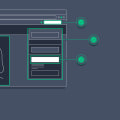Mobile app design is a crucial aspect in the success of any app. With the increasing number of mobile users, having a well-designed and user-friendly app has become a necessity for businesses. In order to stand out in the competitive market, it is important to follow best practices for mobile app UI design. Not only does it enhance the usability of the app, but it also adds visual appeal to attract and retain users.
In this article, we will delve into the best practices for mobile app UI design, covering all aspects from layout and navigation to color schemes and typography. Whether you are a designer, developer, or business owner, this article will provide valuable insights and case studies of successful UI designs that can inspire and guide you in creating an exceptional mobile app. So, let's dive in and explore the world of mobile app UI design!First and foremost, it's important to understand the importance of user-centered design. This approach puts the needs and preferences of the user at the forefront of the design process.
This means conducting thorough research on your target audience, understanding their behaviors and motivations, and using that information to inform your design decisions. By prioritizing the user's needs, you can create a more intuitive and user-friendly interface. Another key aspect of mobile app UI design is responsiveness. With the plethora of devices available today, it's essential to ensure that your app can adapt to different screen sizes and resolutions. This is where responsive design comes into play.
By using flexible grids and layouts, your app will be able to provide an optimal viewing experience for users on various devices. When it comes to the latest trends in UI and UX design, there are a few key aspects to consider. One trend is the use of micro-interactions, which are subtle animations or visual feedback that occur in response to a user's action. These can add a touch of personality to your app while also providing valuable feedback to the user. Another trend is the use of bold typography. This not only adds visual interest to your app but also helps with readability and accessibility.
Additionally, incorporating dark mode into your app can be a popular choice, as it reduces eye strain and conserves battery life for users. There are also various resources and tools available to help with your mobile app UI design projects. From prototyping tools like Adobe XD and Figma to user testing platforms like UserTesting and Optimal Workshop, these resources can help streamline the design process and improve the overall usability of your app. Ultimately, the key to successful mobile app UI design is to continuously gather feedback from users and make adjustments accordingly. As technology and user preferences evolve, so should your design. By implementing best practices, staying up-to-date with trends, and utilizing available resources, you can create a visually appealing and user-friendly interface for your mobile app.
Responsive Design for Various Devices
In today's digital age, more and more users are accessing websites and apps through various devices with different screen sizes and resolutions.This makes it crucial for mobile app UI design to incorporate responsive design to ensure a seamless experience for all users, regardless of the device they are using. Responsive design allows your app to adapt to different screen sizes and resolutions, making it easier for users to navigate and interact with your app. By using HTML structure with for main keywords and for paragraphs, you can ensure that your app's design remains consistent and visually appealing across all devices. This not only enhances the usability of your app but also improves its overall visual appeal.
Make sure to implement responsive design in your mobile app UI design to cater to a wider audience and provide a positive user experience.
Utilizing Resources and Tools
One of the most important aspects of mobile app UI design is utilizing resources and tools that can streamline the design process. This includes prototyping and user testing, which can help you create a more user-centered and visually appealing design. Prototyping involves creating a basic version of your app's interface to test its functionality and usability. This can help you identify any potential issues or areas for improvement before investing time and resources into the full development process. Additionally, user testing involves gathering feedback from real users on your app's design. This can provide valuable insights on how to improve the user experience and make your app more intuitive and easy to use. By incorporating these resources and tools into your design process, you can save time and effort while also ensuring that your app's UI meets the expectations of your target audience.Remember, a well-designed UI can greatly enhance the success of your mobile app, so it's important to utilize all available resources to achieve this goal.
Incorporating Latest Trends in UI/UX Design
In today's ever-changing digital landscape, it's important for mobile app developers to stay up-to-date with the latest trends in UI and UX design. Incorporating these trends into your app can not only enhance its usability and visual appeal, but also keep users engaged and satisfied. One trend that has gained popularity in recent years is micro-interactions. These are small, subtle animations or visual responses that occur when a user interacts with an app. They can range from a simple button change to a more complex loading animation.Micro-interactions add an element of delight and surprise to the user experience, making it more engaging and memorable. Another key trend is typography. The use of typography in UI design has evolved from simply choosing a font to creating a hierarchy and visual hierarchy that guides the user through the app. Designers are now experimenting with different font sizes, weights, and styles to create a more dynamic and visually appealing interface. Lastly, dark mode has become increasingly popular in recent years. This feature allows users to switch to a darker color scheme for their app, which can be easier on the eyes and conserve battery life for devices with OLED screens.
With more and more apps offering dark mode as an option, it's important for developers to consider implementing it in their designs to stay competitive.
Creating a User-Centered Design
use HTML structure with user-centered design only for main keywords and When it comes to UI design, one of the most important factors to consider is the user. After all, the success of your mobile app depends on how well your target audience responds to it. This is why creating a user-centered design should be a top priority for any app developer or designer. By understanding your users and their needs, you can create a design that is intuitive, easy to navigate, and visually appealing.Here are some key points to keep in mind when prioritizing your users in UI design:
- Conduct thorough user research to understand their behaviors and preferences.
- Use wireframes and prototypes to test and gather feedback from users.
- Incorporate user feedback into your design to improve usability.
- Consider accessibility for users with disabilities or special needs.
Continuously Gathering Feedback
One of the most important aspects of mobile app UI design is continuously gathering feedback from users. This allows you to evolve your design to meet changing technology and user preferences. By regularly collecting feedback, you can identify any pain points or areas of improvement in your app's design.This can help you make necessary adjustments to enhance the overall usability and user experience. Furthermore, gathering feedback allows you to stay updated on the latest trends and preferences in UI design. As technology and user behaviors continue to evolve, it is crucial to adapt your design accordingly to meet the ever-changing needs and expectations of your users. To continuously gather feedback, consider implementing features such as in-app surveys, user testing, and analyzing user data.
This will not only help improve your current design but also provide valuable insights for future updates and developments. By following these best practices for mobile app UI design, you can enhance the usability and visual appeal of your app. Remember to prioritize the needs of your users, stay up-to-date with trends, and utilize available resources to continuously improve your design. With a well-designed interface, you can provide an exceptional user experience for your audience.


